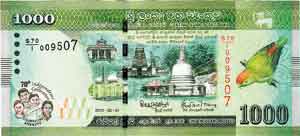Celebrating diversity: Modified Rs. 1000 note for Independence
 The Central Bank of Sri Lanka has issued a modified One Thousand Rupee currency note dated 2018-02-04 to commemorate the 70th Anniversary of Independence with the theme “Celebrating Diversity”.
The Central Bank of Sri Lanka has issued a modified One Thousand Rupee currency note dated 2018-02-04 to commemorate the 70th Anniversary of Independence with the theme “Celebrating Diversity”.
The image of Ramboda Tunnel at the centre of the current Rs. 1000 note has been replaced by a montage of an artist’s impression of a vihara, kovil, church and mosque. Replacing the butterfly on the lower left corner, is a logo with a Sinhala boy, a Muslim boy with hat, a Burgher girl with red hair to left and a Tamil girl to the right. The words 70th Independence Celebration in upper right and CELEBRATING DIVERSITY are seen at the bottom. Does this logo represent more than Diversity of Race and Religion?
It is the first currency note to circulate with the signature of the Minister of Finance Mangala Samaraweera, and was issued to public circulation on February 6. 5 Million notes have been printed by De La Rue at Biyagama,with Serial prefix S70 and 5000 of them issued in commemorative folder printed by Print Care are available for salefrom the CBSL Economic History Museum for Rs 1300.
CBSL’s 1st commemorative currency note, a Rs 200 polymer note issued for the 50th Anniversary of Independence in 1998, was slabbed and sold to the public. The modified Rs 500 issued in 2013 for the CHOGM was the 3rd note embedded in acrylic and was gifted to delegates. This is the fourth commemorative note and the early serial numbers have also been slabbed in acrylic. Number 30 is on display at the Currency Museum. They are rare collectibles.
A media report over five years ago in September 2012 said that CBSL has given a written undertaking to include the words “this currency note issued on behalf the Government of Sri Lanka is valid for any financial transaction within Sri Lanka” in the Tamil and English language and provide equal prominence to all three languages when issuing currency notes in future. This has not yet been implemented.
Since the inception of currency issue in Ceylon in 1785, the value of the note has appeared in all three languages. In India, the language panel of the currency note displays the denomination of the note in 15 of the 22 official languages of India. The legality is only in English and Hindi. In Ceylon, English which had been used since 1800, changed to Sinhala in 1956. Sri Lanka should revert and put legality in the link language of English, like it does in this case the text in logo, and the central image descriptions in all the regular notes.
The identification of the four sites is unfortunately not given even in the folder. According to the artist Kelum Gunaseka -The Vihara-Halmillewa Purana RajamahaVihara is near Kebithigollewa, the Vallipuram Kovil is the oldest in Jaffna, the Madu Church in Mannar is a sacred site and the Mosque, is in Kalmunai. Vihara-Halmillewa Purana Rajamaha Vihara is near Sulugal Dambulu Purana Rajamaha Vihara, Kebithigollewa.
(The writer maintains an educational website on Lankan currency notes at
http://notes.lakdiva.org )


